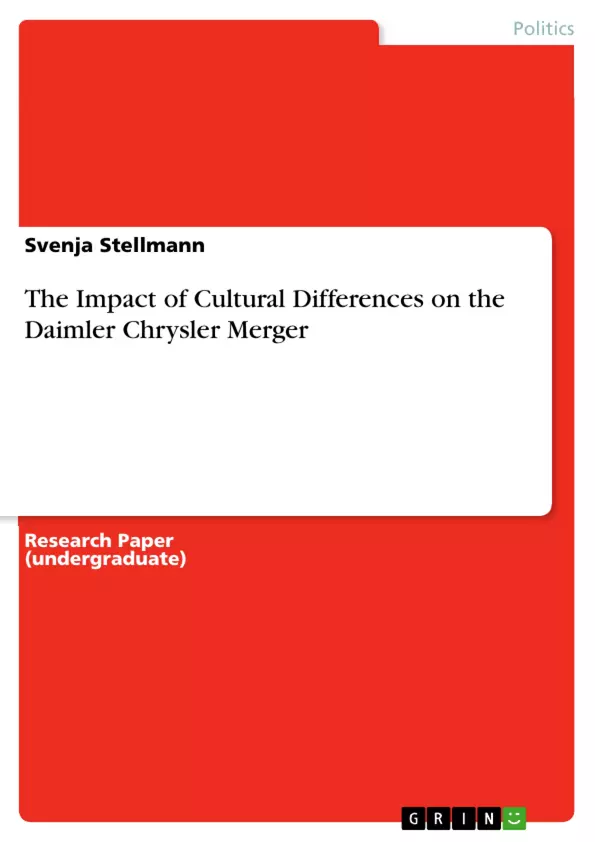The Merger of DaimlerChrysler in 1998 is regarded to be the biggest merger in the automotive industry. In academic literature there is consensus about the fact that cultural issues had a major impact on the merger’s failure. Bearing in mind the importance of organisational culture on the success of M&A, this study aims to provide an in-depth analysis of the famous DaimlerChrysler merger.
The researcher will reveal the organisations’ cultural issues which arose during and after the merger and she will explain the impact of these issues on different organisational levels. The analysis will be conducted with the help of the theoretical frameworks of Schein (1984) and Hofstede (2001).
Findings show that cultural differences have had an impact throughout all organisational levels. Due to this finding it is concluded that the merger was about to fail from the beginning on.
Inhaltsverzeichnis (Table of Contents)
- ABBREVIATIONS
- LIST OF EXHIBITIONS AND TABLES
- INTRODUCTION
- SETTING THE SCENE
- METHOD
- .3
- .3
- .4
- .6
- .6
- THEORETICAL FRAMEWORKS
- Geert Hofstede (2001)
- Edgar Schein (1984)
- ANALYSIS
- Cultural issues under the light of Schein's (1984) model.
- Cultural issues regarding to Hofstede's theory.
- CONCLUSION
- APPENDIX A
- References
- Bibliography
- APPENDIX B
- Additional Information
Zielsetzung und Themenschwerpunkte (Objectives and Key Themes)
This study aims to provide a detailed analysis of the DaimlerChrysler merger, focusing on the cultural issues that arose during and after the merger and their impact on various organizational levels. The research will explore how cultural differences contributed to the challenges encountered by the merger, ultimately influencing its success.
- The impact of cultural differences on the DaimlerChrysler merger
- The role of organizational culture in M&A success
- Cultural issues arising from international mergers
- Analysis of organizational culture using the theoretical frameworks of Schein (1984) and Hofstede (2001)
- The importance of cultural alignment in mergers and acquisitions
Zusammenfassung der Kapitel (Chapter Summaries)
- Introduction: This chapter sets the context for the study by discussing the increasing trend of international mergers and acquisitions (M&A) and the high failure rate associated with them. It highlights the significance of understanding cultural differences in ensuring M&A success, particularly referencing the DaimlerChrysler merger as a case study.
- Setting the Scene: This chapter provides a brief overview of the DaimlerChrysler merger, its historical context, and the motivations behind it. It may also include details about the companies' individual cultures before the merger.
- Method: This chapter describes the research methodology used in the study, outlining the data collection and analysis methods employed to investigate the cultural issues in the DaimlerChrysler merger.
- Theoretical Frameworks: This chapter introduces the theoretical frameworks of Schein (1984) and Hofstede (2001) and explains how these frameworks will be used to analyze the cultural aspects of the merger.
- Analysis: This chapter presents a detailed analysis of the cultural issues identified in the DaimlerChrysler merger, using the theoretical frameworks of Schein and Hofstede. It explores how these issues manifested themselves at various organizational levels and how they contributed to the challenges encountered during the merger.
Schlüsselwörter (Keywords)
The main keywords and focus topics of the study are: DaimlerChrysler merger, organizational culture, cultural differences, M&A, Hofstede's cultural dimensions, Schein's levels of culture, cultural alignment, cultural issues, integration, globalization, international business, cross-border mergers, collaboration, organizational success.
- Quote paper
- Svenja Stellmann (Author), 2010, The Impact of Cultural Differences on the Daimler Chrysler Merger, Munich, GRIN Verlag, https://www.grin.com/document/163081



